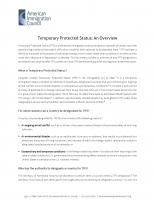- Fact Sheet
Temporary Protected Status: An Overview
Published
Temporary Protected Status: An Overview
Temporary Protected Status (TPS) is a temporary immigration status provided to nationals of certain countries experiencing problems that make it difficult or unsafe for their nationals to be deported there. TPS has been a lifeline to hundreds of thousands of individuals already in the United States when problems in a home country make their departure or deportation untenable. This fact sheet provides an overview of how TPS designations are determined, what benefits TPS confers, and how TPS beneficiaries apply for and regularly renew their status.
What is Temporary Protected Status?
Congress created Temporary Protected Status (TPS) in the Immigration Act of 1990. It is a temporary immigration status provided to nationals of specifically designated countries that are confronting an ongoing armed conflict, environmental disaster, or extraordinary and temporary conditions. It provides a work permit and protection from deportation to foreign nationals from those countries who are in the United States at the time the U.S. government makes the designation.iv As of March 31, 2024 there were approximately 863,880 people with TPS living in the United States.v In addition, an estimated 331,300 people may be eligible for TPS under three redesignations and one new designation since that date.
For what reasons can a country be designated for TPS?
A country may be designated for TPS for one or more of the following reasons:
- An ongoing armed conflict, such as a civil war, that poses a serious threat to the personal safety of returning nationals;
- An environmental disaster, such as an earthquake, hurricane, or epidemic, that results in a substantial but temporary disruption of living conditions, and because of which the foreign state is temporarily unable to adequately handle the return of its nationals; or
- Extraordinary and temporary conditions in the foreign state that prevent its nationals from returning to the state in safety (unless the U.S. government finds that permitting these nationals to remain temporarily in the United States is contrary to the U.S. national interest).
Who has the authority to designate a country for TPS?
The Secretary of Homeland Security has discretion to decide when a country merits a TPS designation. The Secretary must consult with other government agencies prior to deciding to designate a country—or part of a country—for TPS. Although these other agencies are not specified in the statute, these consultations usually involve the Department of State, the National Security Council, and occasionally the Department of Justice (DOJ). The Secretary’s decision as to whether or not to designate a country for TPS is not subject to judicial review, according to immigration law.
How long are TPS designations?
A TPS designation can be made for 6, 12, or 18 months at a time. At least 60 days prior to the expiration of TPS, the Secretary must decide whether to extend or terminate a designation based on the conditions in the foreign country. Decisions to begin, extend, or terminate a TPS designation must be published in the Federal Register. If an extension or termination decision is not published at least 60 days in advance of expiration, the designation is automatically extended for six months. The law does not define the term “temporary” or otherwise limit the amount of time for which a country can have a TPS designation.
Who is eligible for TPS?
In order to qualify for TPS, an individual must:
- Be a national of the foreign country with a TPS designation (or if stateless, have last habitually resided in a country with a TPS designation);
- Be continuously physically present in the United States since the effective date of designation;
- Have continuously resided in the United States since a date specified by the Secretary of Homeland Security; and
- Not be inadmissible to the United States or be barred from asylum for certain criminal or national security-related reasons, such as individuals who have been convicted of any felony or two or more misdemeanors.
Nationals of a designated country do not automatically receive TPS, but instead must register during a specific registration period and pay significant fees. In addition, an individual’s immigration status at the time of application for TPS has no effect on one’s eligibility, nor does the previous issuance of an order of removal.
What does TPS authorize a noncitizen to do?
An individual who is eligible for TPS must register by submitting an application to USCIS, an agency of the Department of Homeland Security (DHS). If a person demonstrates eligibility and USCIS grants TPS, that person receives temporary protection from deportation and temporary authorization to work in the United States. TPS beneficiaries have also been eligible in the past for advance parole, which provides permission to travel abroad and return to the United States, but they must apply for it separately. In July of 2022, USCIS discontinued the use of advance parole for TPS recipients and instead created “Form I-512T, Authorization for Travel by a Noncitizen to the United States,” a TPS-specific travel document that uses a separate legal authority to permit TPS recipients to travel outside the United States and be admitted on their return. Beneficiaries are not eligible for any public assistance by virtue of their TPS status.
Which countries have TPS?
As of January 2025, the following 17 countries were designated for TPS and the designation had not expired:
- Afghanistan (Extended until May 20, 2025)
- Burma (Valid through November 25, 2025)
- Cameroon (Extended until June 7, 2025)
- El Salvador (Extended until September 9, 2026)
- Ethiopia (Valid through December 12, 2025)
- Haiti (Extended through February 3, 2026)
- Honduras (Extended until July 5, 2025)
- Lebanon (Valid through May 27, 2026)
- Nepal (Extended until June 24, 2025)
- Nicaragua (Extended until July 5, 2025)
- Somalia (Extended until March 17, 2026)
- South Sudan (Extended until May 3, 2025)
- Sudan (Extended until October 19, 2026)
- Syria (Extended until September 30, 2025)
- Ukraine (Extended until October 19, 2025)
- Venezuela (Extended until October 2, 2025)
- Yemen (Extended until March 3, 2026)
Which countries have had TPS in the past?
Since TPS was created, the following countries or parts of countries have had TPS designations that are now terminated:
- Angola (Expired March 29, 2003)
- Bosnia-Herzegovina (Expired February 10, 2001)
- Burundi (Expired May 2, 2009)
- Guinea (Expired May 21, 2017)
- Guinea-Bissau (Expired September 10, 2000)
- Province of Kosovo (Expired December 8, 2000)
- Kuwait (Expired March 27, 1992)
- Lebanon (Expired April 9, 1993)
- Liberia (Expired May 21, 2017)
- Montserrat (Expired August 27, 2004)
- Rwanda (Expired December 6, 1997)
- Sierra Leone (Expired May 21, 2017)
Does TPS create a path to permanent residence or citizenship?
TPS does not provide beneficiaries with a separate path to lawful permanent residence (a green card) or citizenship. However, a TPS recipient who otherwise is eligible for permanent residence may apply for that status.
Generally, a person who entered the United States without inspection is not eligible to apply for permanent residence. Six federal appellate circuits previously ruled on this issue. Three federal appellate circuits (the Sixth, Eighth, and Ninth Circuits) ruled that a person with valid TPS status could adjust status to lawful permanent residence if otherwise eligible through a family-based or employment-based petition, even if he or she entered the United States without inspection. Three other federal appellate courts (the Third, Fifth, and Eleventh Circuits) ruled that a TPS recipient who entered without inspection is not eligible to adjust to permanent residence.
In June 2021, the Supreme Court subsequently ruled that a TPS recipient who entered the United States without inspection is not eligible to adjust to permanent residence from within the United States, overturning the prior decisions by the Sixth, Eighth, and Ninth Circuits. In order to gain permanent resident status, a TPS recipient who initially entered the United States without inspection must depart the country to have a visa processed at a consular post. For many TPS holders, a departure to have a visa interview would trigger bars to re-entry for up to 10 years.
Alternatively, some TPS recipients may be eligible to adjust status if they were granted advance permission from USCIS (referred to as advance parole), traveled abroad, and were paroled back into the United States. After July 2022, when USCIS discontinued the use of advance parole for TPS recipients, some TPS recipients may become eligible to adjust status after being granted authorization to travel through a TPS-specific travel document, and then being inspected and admitted upon their return.
What happens to a TPS beneficiary when a TPS designation ends?
TPS beneficiaries return to the immigration status that the person held prior to receiving TPS, unless that status has expired or the person has successfully acquired a new immigration status. TPS beneficiaries who entered the United States without inspection and who are not eligible for other immigration benefits, for example, would return to being undocumented at the end of a TPS designation and become subject to removal.
How are “Deferred Enforced Departure” and “Extended Voluntary Departure” related to TPS?
Deferred Enforced Departure (DED) is very similar to TPS but derives from the president’s foreign policy authority rather than from a specific law. There are no explicit criteria for making DED decisions or for determining who would be eligible for DED once a designation is determined. Just like TPS holders, DED beneficiaries receive a work permit and stay of deportation; however, they are not permitted to travel abroad.
As of December 2024, there are four groups designated for DED:
- Liberian nationals (effective until June 30, 2026);
- Certain residents of Hong Kong (effective until February 5, 2027).
- Palestinian nationals (effective until August 14, 2025).
- Lebanese nationals (effective until January 26, 2026)
Extended Voluntary Departure (EVD) was the predecessor to TPS prior to the Immigration Act of 1990. It was a discretionary authority used by the Attorney General (at a time when the Immigration and Naturalization Service was housed in DOJ) to give nationals of certain countries experiencing turbulent country conditions temporary permission to remain in the United States. Congress eliminated EVD with the creation of TPS.
Help us fight for immigration justice!
The research is clear – immigrants are more likely to win their cases with a lawyer by their side. But very few can get attorneys.
Introducing the Immigration Justice Campaign Access Fund.
Your support sends attorneys, provides interpreters, and delivers justice.

Immigration Justice Campaign is an initiative of American Immigration Council and American Immigration Lawyers Association. The mission is to increase free legal services for immigrants navigating our complicated immigration system and leverage the voices and experiences of those most directly impacted by our country’s immigration policies to inform legal and advocacy strategies. We bring together a broad network of volunteers who provide legal assistance and advocate for due process for immigrants with a humane approach that includes universal legal representation and other community-based support for individuals during their immigration cases.

